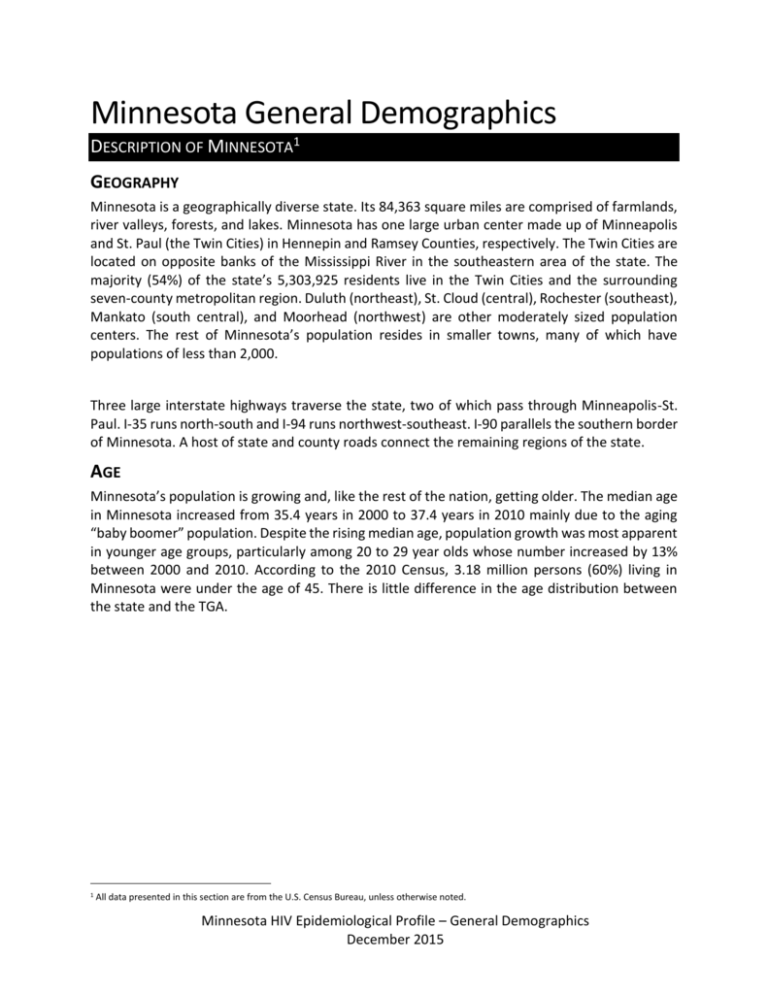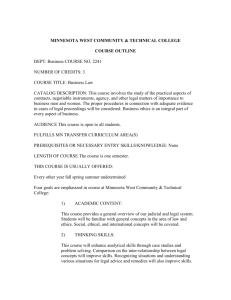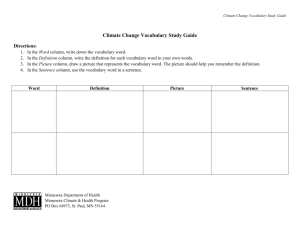
Minnesota General Demographics
DESCRIPTION OF MINNESOTA1
GEOGRAPHY
Minnesota is a geographically diverse state. Its 84,363 square miles are comprised of farmlands,
river valleys, forests, and lakes. Minnesota has one large urban center made up of Minneapolis
and St. Paul (the Twin Cities) in Hennepin and Ramsey Counties, respectively. The Twin Cities are
located on opposite banks of the Mississippi River in the southeastern area of the state. The
majority (54%) of the state’s 5,303,925 residents live in the Twin Cities and the surrounding
seven-county metropolitan region. Duluth (northeast), St. Cloud (central), Rochester (southeast),
Mankato (south central), and Moorhead (northwest) are other moderately sized population
centers. The rest of Minnesota’s population resides in smaller towns, many of which have
populations of less than 2,000.
Three large interstate highways traverse the state, two of which pass through Minneapolis-St.
Paul. I-35 runs north-south and I-94 runs northwest-southeast. I-90 parallels the southern border
of Minnesota. A host of state and county roads connect the remaining regions of the state.
AGE
Minnesota’s population is growing and, like the rest of the nation, getting older. The median age
in Minnesota increased from 35.4 years in 2000 to 37.4 years in 2010 mainly due to the aging
“baby boomer” population. Despite the rising median age, population growth was most apparent
in younger age groups, particularly among 20 to 29 year olds whose number increased by 13%
between 2000 and 2010. According to the 2010 Census, 3.18 million persons (60%) living in
Minnesota were under the age of 45. There is little difference in the age distribution between
the state and the TGA.
1
All data presented in this section are from the U.S. Census Bureau, unless otherwise noted.
Minnesota HIV Epidemiological Profile – General Demographics
December 2015
Age Distribution in Minnesota and in TGA
Minnesota
Age
(n = 5,303,925)
< 13
17.3%
13 – 19
9.6%
20 – 24
6.7%
25 – 29
7.0%
30 – 34
6.5%
35 – 39
6.2%
40 – 44
6.7%
45 – 49
7.7%
50 – 54
7.6%
55 – 59
6.6%
60 +
18.2%
Minneapolis – St. Paul TGA
(n = 3,279,833)
18.1. %
9.6%
6.5%
7.6%
7.0%
6.7%
7.2%
7.9%
7.5%
6.3%
15.8%
RACE/ETHNICITY
While Minnesota is predominantly White (approximately 85%), there has been an increase in the
number of Black, Hispanic, and Asian/Pacific Islander persons living in Minnesota since 2000. At
that time, 89% of Minnesotans were White, 3.5 Black, 2.9% Hispanic, 1.1% Native American, and
2.9% Asian. However, excluding the 2.4% of the Minnesota population that indicated two or more
races, Black, Hispanic, and Asian/Pacific Islander populations increased by about 60%, 75%, and
50% respectively. As of 2010, there were approximately 274,000 Black, 250,000 Hispanic, and
216,000 Asian/Pacific Islander persons living in Minnesota. Additionally, data from the 2011 –
2013 American Community Survey (ACS) show that foreign-born individuals account for 7.4% and
9.7% of the state and TGA population, respectively, compared to 5% and 7% in 2000.
The table below shows the race/ethnicity distribution for Minnesota and the TGA. While the race
distribution does not differ greatly by gender, it does vary by geography. A significantly smaller
percent of both White males (78% vs. 83%) and females (79% vs. 83%) reside in the TGA
compared to the state as a whole. Additionally, census data show differences in age for Whites
versus other groups. Twenty-one percent of non-Hispanic Whites in Minnesota were under the
age of 18 compared to 35.2% for African Americans, 31.5% for Asians/Pacific Islanders, 40.5%
for Hispanics 32.9% American Indians, and 56.3% of those identifying as multi-racial (two or more
races).
Minnesota HIV Epidemiological Profile – General Demographics
December 2015
Race and Ethnicity Distribution by Gender in Minnesota and TGA
Minnesota
(n=2,632,132) (n=2,671,793)
Race / Gender
Male
Female
White (non-Hispanic)
82.7%
83.4%
Black / African American
5.3%
5.0%
American Indian
1.1%
1.1%
Asian / Pacific Islander
4.0%
4.2%
Other race
2.1%
1.8%
Two or more races
2.4%
2.4%
Hispanic / Latino*
5.0%
4.4%
*Includes all races
Minneapolis-St. Paul TGA
(n=1,618,907) (n=1,660,926)
Male
Female
78.3%
78.9%
7.5%
78.3%
0.7%
0.7%
5.6%
5.9%
2.5%
2.2%
2.8%
2.8%
5.7%
5.0%
Of note is the growing number of African immigrants in Minnesota. The Minnesota State
Demographer’s office estimates there are 72,9302 African-born persons living in Minnesota in
2011. However, many believe this to be an underestimate of the true African population in
Minnesota, with some community members estimating that number at close to 100,000 3.
Somalia, Ethiopia, and Liberia are the most common countries of origin although nearly every
country in Africa is represented in Minnesota. Data from the MDH Refugee Health Program
indicate that the number of sub-Saharan African primary refugees arriving in Minnesota has
declined dramatically between 2006 and 2013 (from 4,764 cases in 2006 to 953 cases in 2013 –
a decrease of 80%).
Additionally, in 2000 Minnesota became one of six initial sites in the United States to receive HIVinfected refugees. Prior to November 2009, immigrants, including refugees, were not permitted
entry into the U.S. if they tested positive for HIV during their overseas physical exam unless they
obtained a waiver. Agencies with local offices in the Twin Cities coordinated the arrival and
resettled 200 HIV-infected refugees to Minnesota from August 2000 through December 2010, of
which the majority were from African countries. However, beginning in 2010, the Federal
Government reversed the statute barring entry for HIV positive immigrants. Consequently, HIV
infection is no longer a barrier for entering the United States. Therefore, Minnesota added
routine HIV screening to the refugee screening protocol in 2010.
2
Based on U.S. Census 2010 data, the Minnesota State Demographic Center estimates that there are 380,764 foreign-born persons, including
72,930 African-born persons are living in Minnesota out of a total population of 5,303,925.
3 The American Community Survey is conducted by the U.S. Census Bureau for the years in between the decennial census. Because there are
many reasons African-born persons may not be included in the census count (e.g. difficulties with verbal or written English), even 50,000 is
likely an underestimate of the actual size of the African-born population living in Minnesota. Anecdotal estimates from African community
members in Minnesota are as high as 100,000.
Minnesota HIV Epidemiological Profile – General Demographics
December 2015
SOCIOECONOMIC STATUS
Poverty and Income
Minnesota overall has fared somewhat better than the nation as a whole in regards to poverty
and income. According to the 2011-2013 ACS, an estimated 11.6% of Minnesotans were living
below the Federal Poverty Level compared to 15.9% nationally. Likewise, the per capita income
from 2011-2013 for the United States was $27,884 and $30,902 in Minnesota. While these
aggregate numbers are favorable, they misrepresent the disproportionate impact poverty has on
persons of color. The 2011-2013 ACS estimates that 12% of all Minnesotans were living at or
below the poverty level, however, this percent varied greatly by race, with 8% of Whites at or
below the poverty level compared to 36%, 35%, 17%, and 24% of Blacks, American Indians,
Asians/Pacific Islanders, and Hispanics, respectively.
Employment
According to Minnesota Department of Employment and Economic Development, Minnesota’s
unemployment rate decreased from 5.6% in 2012 to 4.1% in 2014. This is the lowest rate of
unemployment since 2006 and the 2014 unemployment rate in Minnesota is substantially lower
than the 2014 national unemployment rate average of 6.2%. However, the overall
unemployment rates disguise staggering racial disparities. The 2011-2013 ACS indicated an
unemployment rate of 17.3%, 10.1% and 18.3% for Blacks, Hispanics and American Indians,
respectively in Minnesota compared to 5.4% among white (non-Hispanics).
Education
Minnesota’s emphasis on education is reflected in the low statewide percentage (7.7%) of people
aged 25 years or older who have less than a high school education; the national average is 14.4%.
However, the percentage of persons with less than a high school education is greater for persons
of color in Minnesota. According to the 2011-2013 ACS, 17% of Black men and 22% of Black
women are estimated to have less than a high school education compared to 6% and 5% of White
men and women, respectively. High school graduation rates are even lower among
Hispanics/Latinos, with 38% and 33% of Hispanic males and females not having a high school
diploma, respectively.
ACCESS TO HEALTH CARE
Health Insurance
Overall, Minnesota has one of the lowest rates of uninsured residents in the nation. According to
data released from the 2013 Minnesota Health Access Survey, 8.2% of Minnesotans were not
covered by health insurance at the time of the survey compared to 9.0% in 2011, 9.0% in 2009,
7.2 in 2007 and 7.7% in the 2004 survey. However, the findings in this study suggest that
significant differences continue to exist according to race/ethnicity, age, and country of birth.
Minnesota HIV Epidemiological Profile – General Demographics
December 2015
Notable differences continue to exist among the different race/ethnic groups. While only 6.0%
of Whites were uninsured in 2013, the percentages among Hispanics (34.8%), American Indians
(18.0%), Blacks (14.7%), and Asians (13.2%) were considerably higher.
In 2013, persons aged 18-24 and 25-34 experienced uninsurance rates significantly above the
statewide rate (13.6% and 17.1% for 18-24 and 25-34 year olds, respectively, compared to 8.2%
statewide). Persons aged 0-17 and over 65 had uninsurance rates significantly below the
statewide rate 6.2% and 0.4%, respectively).
Country of birth is a significant factor in uninsurance rates in Minnesota. In 2013, people born in
the United States had significantly lower uninsurance rate than the statewide rate of 6.6% while
those not born in the United States had a significantly higher uninsurance rate of 26.4%.
Prenatal Care
Minnesota is known for its caliber of health care. Unfortunately, when it comes to prenatal care,
women do not access health services equally. According to unpublished data from the Minnesota
Pregnancy Risk Assessment Monitoring System, 85.3% of Minnesota mothers giving birth in 2011
began prenatal care in the first trimester. However, while 90.3% of White women began prenatal
care in the first trimester, only 69.8% of Black, 66.0% of American Indian, and 68.1% of Hispanic
women did. Additionally, 87.5% of US-born mothers began prenatal care in the first trimester
compared to 72.9% of foreign-born mothers.
GAY, LESBIAN, BISEXUAL AND TRANSGENDER (GLBT) PERSONS IN MINNESOTA
Accurate estimates of the GLBT4 population in Minnesota are unavailable. However, the 2010
Census provides some data related to GLBT persons in Minnesota. Although not a valid measure
of the extent of same sex relationships in Minnesota, unmarried partners of the same sex made
up an estimated 13,718 households in Minnesota in the year 2010, with approximately 70% of
those households located in the TGA.
There have been some national studies that have attempted to estimate the prevalence of same
sex behavior, which is different than estimating the number of GLBT persons since some people
may engage in same sex behavior but not identify as GLBT. In early work by Kinsey and colleagues
in the 1940s and 1950s, 8% of men5 and 4% of women6 reported exclusively same gender sex for
at least 3 years during adulthood. Generalizing these findings to the general population is very
questionable because these data were based on convenience samples.
4 The
term “GLBT” (gay, lesbian, bisexual, or transgender) refers to sexual identity. “MSM” (men who have sex with men), another term used
throughout this document, refers only to sexual behavior and is not synonymous with sexual identity.
5 Kinsey AC, Pomeroy WB, Martin CE. Sexual Behavior in the Human Male. Philadelphia: WB Saunders, 1948
6
Kinsey AC, Pomeroy WB, Martin CE. Sexual Behavior in the Human Female. Philadelphia: WB Saunders, 1953
Minnesota HIV Epidemiological Profile – General Demographics
December 2015
Subsequent to this work, studies more representative of the general U.S. population have been
undertaken. Comparing national surveys from 1970 and 1991, Seidman and Rieder estimated
that from 1% to 6% of men had sex with another man in the preceding year7. Another populationbased study estimated the incidence of same sex behavior in the preceding five years at 6% for
males and 4% for females8. Estimates vary for a number of reasons, including varying definitions
of homosexuality and/or methods of data collection. Approximately 77,000 men and 50,000
women in Minnesota would be predicted to engage in same sex behavior using the methodology
from the Sell study. The accuracy of these numbers is difficult to gauge, at best.
More recently, the SHAPE 2010 study conducted in Hennepin County found that 9.2% of adult
males and 4.7% of adult females in Hennepin County identified as GLBT9. Applying these
percentages to the entire state adult population, we would estimate that approximately 182,000
men and 96,000 women identify as GLBT.
Also relevant to the context of GLBT life in Minnesota is the fact that Minnesota and the Twin
Cities, in particular, attract individuals with a variety of sexual orientations. A strong gay
community exists in the Minneapolis-St. Paul area. Additionally, Minnesota is one of sixteen
states and the District of Columbia that has laws banning discrimination based on sexual
orientation and gender identity.
A nationally renowned center for individuals seeking transgender support and services is located
in Minneapolis. Although transgender people identify as heterosexual, bisexual, gay, and lesbian,
variances in gender identity complicate the categorization. Some male to female transgender
individuals identify as lesbian, some as heterosexual, and others as bisexual. Similarly, some
female to male individuals identify as gay, some are heterosexual, and others are bisexual.
Politically, and sometimes for access to services, many transgender individuals find alliances
within the gay and lesbian community.
All of these factors may contribute to a larger GLBT population in Minnesota than would be
predicted based upon national averages. Any estimates for the GLBT population must be used
with caution.
In 2012 MDH began estimating the population of MSM in Minnesota. This estimate generates a
denominator for the most commonly reported risk factor in Minnesota and allows for the
calculation of a rate of infection and rate of prevalence among those in the risk group. It should
be noted that this is an estimate of a risk behavior and not an estimate of GLBT identification.
Estimation is done each year using the most recently available census data for men over the age
of 13 and using the model by on Laumann et al where 9% of the urban population, 4% of the
suburban population and 1% of the rural population are estimated to be MSM. Using 2010 census
data, this methodology estimates that there are 92,788 MSM in Minnesota.
7
Seidman SN, Rieder RO. A review of sexual behavior in the United States. American Journal of Psychiatry, 151(3):330-341, 1994
Sell RL, Wells JA, Wypij D. The prevalence of homosexual behavior and attraction in the United States, the United Kingdom, and France: results
of national population-based samples. Archives of Sexual Behavior, 24:235-248, 1995
9 Hennepin County Human Services and Public Health Department. SHAPE 2010 Adult Data Book, Survey of the Health of All the Population and
the Environment, Minneapolis, Minnesota, March 2011
8
Minnesota HIV Epidemiological Profile – General Demographics
December 2015
TRANSGENDER PERSONS
Minnesota appears to attract a relatively large number of individuals who describe themselves
as transgender due to the available treatment programs and access to hormonal and surgical sex
reassignment.
Studies show that transgender individuals have elevated rates of HIV, particularly among
transgender sex workers. These studies focus primarily on male to female transgender
individuals. Possible reasons for the higher rates among transgender sex workers are more
frequent anal receptive sex, increased efficiency of HIV transmission by the neovagina, use of
injectable hormones and sharing of needles, and a higher level of stigmatization, hopelessness,
and social isolation.
Female to male transgender persons who identify as gay or bisexual may be having sexual
intercourse with biological men who are gay or bisexual. Because the prevalence of HIV is higher
among MSM, female to male transgender persons who identify as gay or bisexual are at greater
risk for HIV than those who identify as heterosexual.
Studies by the University of Minnesota’s Program in Human Sexuality identified specific risk
factors such as sexual identity conflict, shame and isolation, secrecy, search for affirmation,
compulsive sexual behavior, prostitution, and found that transgender identity complicates
talking about sex.10 11
SENSORY DISABILITY
Written and/or verbal communication can be hindered for persons with a sensory disability(ies).
Depending on the medium, general HIV awareness and prevention messages cannot be assumed
to reach such populations. According to 2011 - 2013 ACS data, 3.6% of non-institutionalized
Minnesotans are estimated to be living with hearing difficulty and 3.9% of non-institutionalized
Minnesotans are estimated to be living with vision difficulty.
HOMELESSNESS
Homelessness is also seen as a social determinant of health. According to the 2012 Wilder
Homelessness Survey, an estimated 10,214 people were homeless in Minnesota.12 This number
has increased by 10% since 2009 with the largest reported increase among persons age 55 years
and older (48% increase). Despite this increase of homelessness among older people, persons
age 21 and under still account for the largest proportion of homelessness (46%). For persons who
are HIV positive, homelessness can mean reduced access to treatment and lower survival rates,
Also, persons who are homeless (particularly youth) may be at higher risk for having unprotected
sex and using injection drugs.
10
Bockting WO, Robinson BE, Rosser BR. Transgender HIV prevention: a qualitative needs assessment. AIDS Care, 10(4):505-525, 1998
Bockting WO, Robinson BE, Forberg J, Scheltema K. Evaluation of a sexual health approach to reducing HIV/STD risk in the transgender
community. AIDS Care, 17(3):289-303, 2005
12
http://www.wilder.org/Wilder-Research/Research-Areas/Homelessness/Pages/Statewide-Homeless-Study-Most-Recent-Results.aspx
11
Minnesota HIV Epidemiological Profile – General Demographics
December 2015







